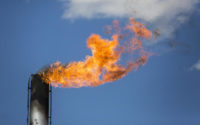National Grid, which serves New York, Massachusetts and Rhode Island, is set to be the second U.S. natural-gas utility to use technology advanced by Google Earth, the Environmental Defense Fund (EDF) and Colorado State University to boost large-scale methane-leak detection. It is launching a $3-billion effort to replace gas pipelines in New York. The technology uses cutting-edge spatial analytics methods and methane sensors, specially fitted to Google Street View cars, to identify leaks and accurately measure the amount of methane escaping.
Under a Dec. 16 agreement approved by the New York Public Service Commission, National Grid will work with EDF and Google to use flow-rate data to prioritize leak repairs in select state service areas, and it has integrated the approach into its ongoing operations.
Public Service Electric and Gas—New Jersey’s largest gas utility, now in the second year of its pipe replacement effort— has used the technology to replace 35% fewer miles of pipe and cut methane emissions by 83%. The utility has replaced about 170 miles in a planned 510-mile, $905-million replacement program. “We looked for areas to get the most safety benefits using company algorithms and applied a secondary formula to identify how much methane was leaking,” says Wade Miller, PSE&G director of gas transmission and distribution engineering. By prioritizing replacement based on emission rates, the company was able to reduce the amount of methane emissions earlier, he says.
With “millions of readings over hundreds of miles of roadway,” the technology found that 37% of PSE&G emissions came from 9% of the pipeline miles tested, says Virginia Palacios, a senior research analyst for EDF’s U.S. climate and energy program. A few large leaks are a major part of the emissions. EDF is most interested in reducing methane releases. “Methane is 84 times more potent than carbon dioxide as a climate forcer 20 years after it is released into the atmosphere,” says Palacios. “The instant it is released, it is about 120 times as powerful as CO.” Carbon dioxide “controls how high global temperatures eventually get, but methane controls how fast we get there,” she adds.
The technology team began using the detection approach in 2014. PSE&G asked to collaborate. “Reducing methane is a serious challenge for utilities,” says Ralph A. LaRossa, PSE&G president and CEO. The utility is replacing old cast-iron and unprotected steel pipe, more prone to leaks, with high-density polyethylene, using its own workforce and contractors. Online publication NJ Spotlight says PSE&G has more cast-iron pipes, the type most prone to leaks, in its system than any other U.S. utility—that is, about 3,900 miles of a 18,000-mile system.
Waltham, Mass.-based National Grid also has been an enthusiastic partner, says Mark Brownstein, chief of EDF’s oil-and-gas program. “By tackling these leaks faster, they will achieve a lot more environmental benefit for their infrastructure dollars,” he points out.




Post a comment to this article
Report Abusive Comment